Install Application
This section lists the steps that are required to deploy the Oracle Health Insurance application on the Oracle WebLogic Server.
Creating The WebLogic Work Managers
By default, the WebLogic Server uses the default work manager to handle thread management and perform self-tuning. This default Work Manager is used by an application when no other Work Managers are specified in the application’s deployment descriptors. For additional information, refer to the WebLogic documentation on Work Managers.
For example, the following application-specific work managers can be configured for more fine-grained control and work load monitoring of the system:
-
a work manager to control the Web Services requests, named "wm/ws-work-manager"
-
and a work manager to control the task or activity processing, named "wm/core-work-manager"
If these work managers are not configured, the system issues warnings at startup like the following example and uses the WebLogic default work manager instead:
<Warning> <WorkManager> <BEA-002919> <Unable to find a WorkManager with name wm/core-work-manager. Dispatch policy wm/core-work-manager maps to the default WorkManager for the application OHI-Claims-2.x.x.x.x>
Refer WebLogic documentation on Work Managers to override the behavior of the default work manager.
Create global work managers through the Administration Console using the steps that are listed in the following table in the given order. Make sure to associate the work managers with the managed servers.
Table 1. Creating The WebLogic Work Managers Step Configuration Value 1
Minimum Threads Constraint
Name
core-work-manager-min-threads-constraint
Count
16
2
Maximum Threads Constraint
Name
core-work-manager-max-threads-constraint
Count
16
3
Fair Share Request Class
Name
core-work-manager-fair-share-req-class
Fair Share
40
4
Work Manager
Name
wm/core-work-manager
Request Class
core-work-manager-fair-share-req-class
Minimum Threads Constraint
core-work-manager-min-threads-constraint
Maximum Threads Constraint
core-work-manager-max-threads-constraint
Capacity Constraint
None Configured
Stuck Thread Action
Ignore stuck threads
5
Minimum Threads Constraint
Name
ws-work-manager-min-threads-constraint
Count
10
6
Maximum Threads Constraint
Name
ws-work-manager-max-threads-constraint
Count
100
7
Fair Share Request Class
Name
ws-work-manager-fair-share-req-class
Fair Share
60
8
Work Manager
Name
wm/ws-work-manager
Request Class
ws-work-manager-fair-share-req-class
Minimum Threads Constraint
ws-work-manager-min-threads-constraint
Maximum Threads Constraint
ws-work-manager-max-threads-constraint
Capacity Constraint
None Configured
Stuck Thread Action
Ignore stuck threads
After configuring work managers, managed servers need to be restarted.
The work manager configuration, like the minimum and maximum threads constraints and the fair share request factors, can be modified at any time in WebLogic Admin Console as is required, for example to increase the number of threads used for task processing.
| This largely depends on hardware capacity, system configuration and the load characteristics and typically requires a thorough understanding of the system’s performance. |
Configuring The Authentication Providers
Oracle Health Insurance applications use the WebLogic Authentication Providers to connect to a user store for authenticating users. Examples of user identity stores for which authentication providers are available include:
-
Oracle Internet Directory (OID)
-
Third party LDAP server
-
An RDBMS like an Oracle database or MySQL database
In addition, it is possible to create custom authentication providers for types of authentication technologies for which WebLogic does not offer out of the box authentication providers.
This section describes an example configuration for an OID or a third party LDAP Authentication Provider. Refer to the WebLogic documentation for additional information and for configuration options of other authentication providers.
-
Login to the WebLogic admin console and click the Security Realms link.
-
Click the myrealm link.
-
Click the Providers tab.
-
Click the New button in order to create a New Authentication Provider
- NOTE
-
In WebLogic Production-mode use the Lock and Edit button before clicking on the New button.
-
Change Name and Type to OHIAuthenticationProvider and OracleInternetDirectoryAuthenticator (or to LDAPAuthenticator in case a third party LDAP server is used) respectively in Create a new Authentication Provider page and click the OK button.
-
Click the OHIAuthenticationProvider link.
-
Change the Control Flag to SUFFICIENT and click Save.
-
Click the Provider Specific tab.
-
Enter/change the values for various fields as shown below and select the option Propagate Cause For Login Exception.
Table 2. Values to Enter or Change Field Value Host
LDAP hostname or IP address
Port
LDAP Port or SSL Port if the LDAP is SSL enabled. For example: 3060. In case LDAPS is used, make sure to check the SSLEnabled flag as well.
Principal
LDAP admin principal: For example: cn=orcladmin
Credential
LDAP admin password
Confirm Credential
LDAP admin password
User Base DN
User Base distinguished name. For example: ou=Users,dc=healthinsurance,dc=oracle,dc=com
All Users Filter
For example: (&(uid=*)(objectclass=person))
User From Name Filter
For example: (&(uid=%u)(objectclass=person))
User Name Attribute
For example.: uid
Group Base DN
If there are no groups in the LDAP, leave this field empty.
There are a few more properties (or fields in the page) which are not mentioned in the table above. Change the values of those fields to suit the LDAP settings. -
Click Save.
-
Click the myrealm link and then DefaultAuthenticaton link. Change the Control Flag to SUFFICIENT and click Save.
-
Restart the WebLogic Server.
Optionally, verify that the authentication provider is configured successfully (after the WebLogic Server is restarted) by following the steps mentioned below:
-
Login to WLS Admin Console and click Security Realms.
-
Click myrealm.
-
Click the Users and Groups tab.

-
See the list of users from OHIAuthenticationProvider (in addition to the default users from DefaultAuthenticator).

Setup JDBC Data Sources
The application connects to the Oracle database through a Data Source that need to be specified in the WLS Server.
|
For security reasons, the database connections used by the application connect to database schemas that do not own database objects. These schemas are only granted the required privileges to use the objects. |
The following sections describe setting up data sources for connecting to:
-
an Oracle database that is running on a single machine
-
an RAC-enabled Oracle database that is running on multiple machines
Data Source for Connecting to an Oracle Database that is Running on a Single Machine
The following table lists details for the Data Source that must be configured in WLS before installing the application for use with an Oracle database that is executed on a single machine (not clustered):
| Data Source Parameters | Non-Clustered database | Explanation |
|---|---|---|
Data Source Type |
Generic Data Source |
|
Data Source Name |
ohi-application-datasource |
Logical name |
JNDI Name |
jdbc/claimsUserOhiApplicationDS |
Used by the application to resolve the Data Source |
Database Type |
Oracle |
|
Database Driver |
Oracle’s Driver (Thin) for Instance connections; Versions:9.0.1,9.2.0,10,11 or Oracle’s Driver (Thin) for Service connections; Versions:9.0.1,9.2.0,10,11 |
|
Database Name |
SID or service name of the database If the name of the Oracle driver that was selected contains the words "for Instance connections" enter the SID. If the name of the Oracle driver contains the words "for Service connections" enter the service name. |
|
Host Name |
Name or IP address of the machine where the database is running |
|
Port |
Port on which the database is running |
|
Database User Name |
ohi_claims_user |
Fixed value, do not change |
Password and Confirm Password |
Password of "ohi_claims_user" |
The schema password as selected during the installation |
Service Name |
Service name of the database |
SID or service name |
Data Source for Connecting to an Oracle RAC Database That is Running on Multiple Machines
To support Oracle RAC features within the Oracle WebLogic Server, Oracle recommends using the Oracle WebLogic Server GridLink Data Source. A single GridLink data source provides connectivity between WebLogic Server and an Oracle Database service targeted to an Oracle RAC cluster. It uses the Oracle Notification Service (ONS) to adaptively respond to state changes in an Oracle RAC instance. An Oracle Database service represents a workload with common attributes that enables administrators to manage the workload as a single entity.
To configure this, the following steps need to be performed. For additional information about GridLink Data Source configuration, refer to the Oracle Weblogic Server documentation.
Configuring The GridLink Data Source
-
Login to the WebLogic admin server console and click the Services/Data Sources link.
-
Click New and select the option GridLink Data Source.
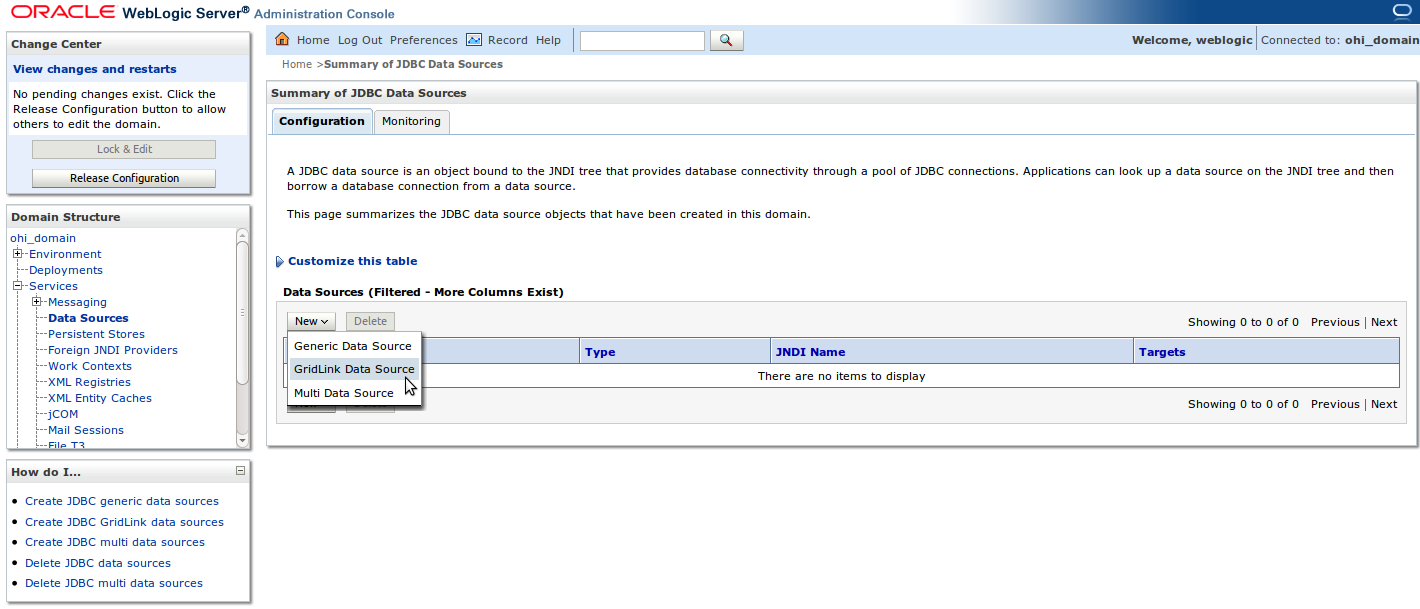
In the WLS Production-mode use the Lock & Edit button before clicking the New button. -
Change the value of Name to ohi-application-datasource and enter jdbc/claimsUserOhiApplicationDS in JNDI Name. Click Next.
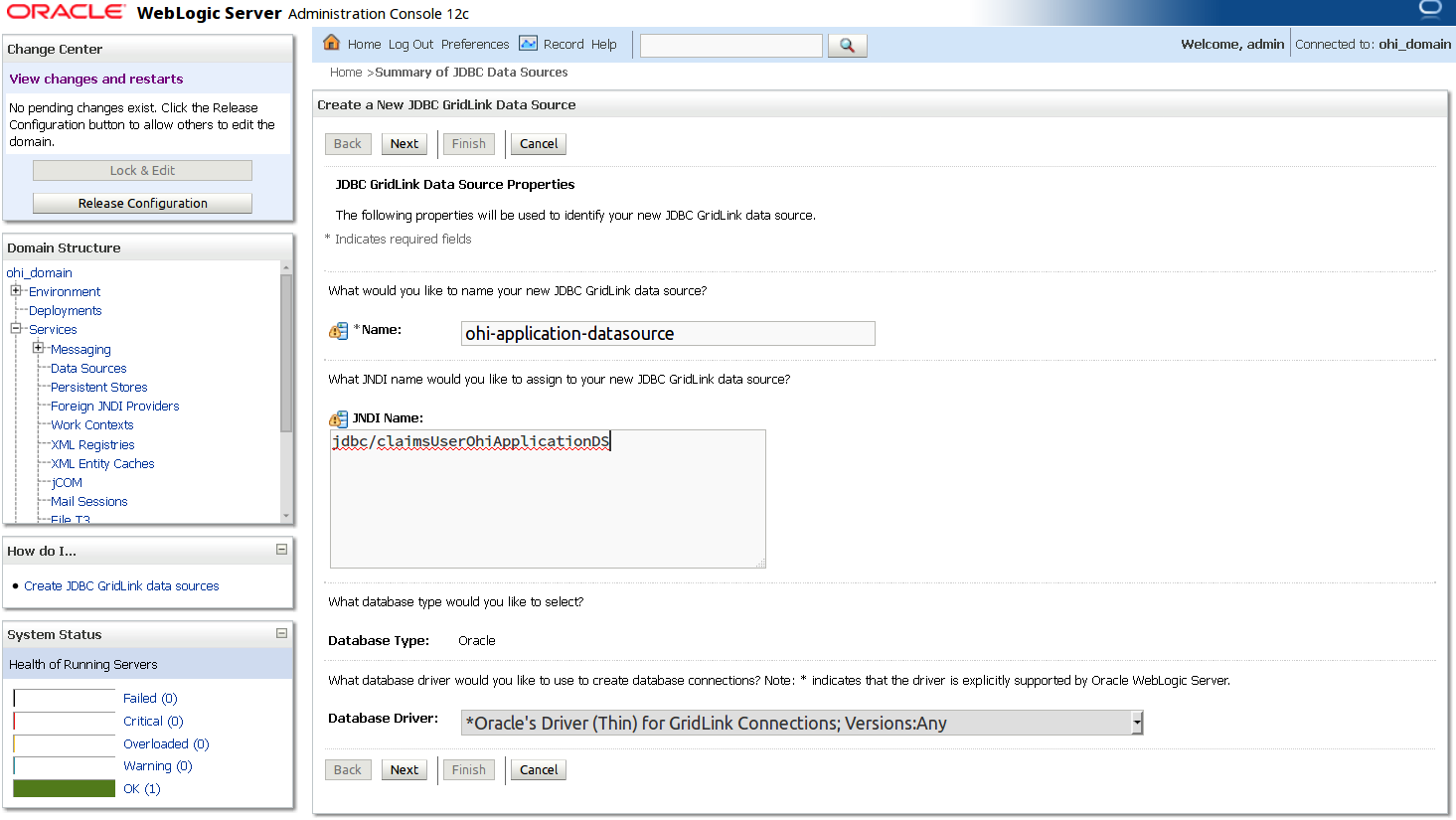
-
In the Transaction Options page, accept the default settings (Supports Global Transactions and One-Phase Commit) and click Next.
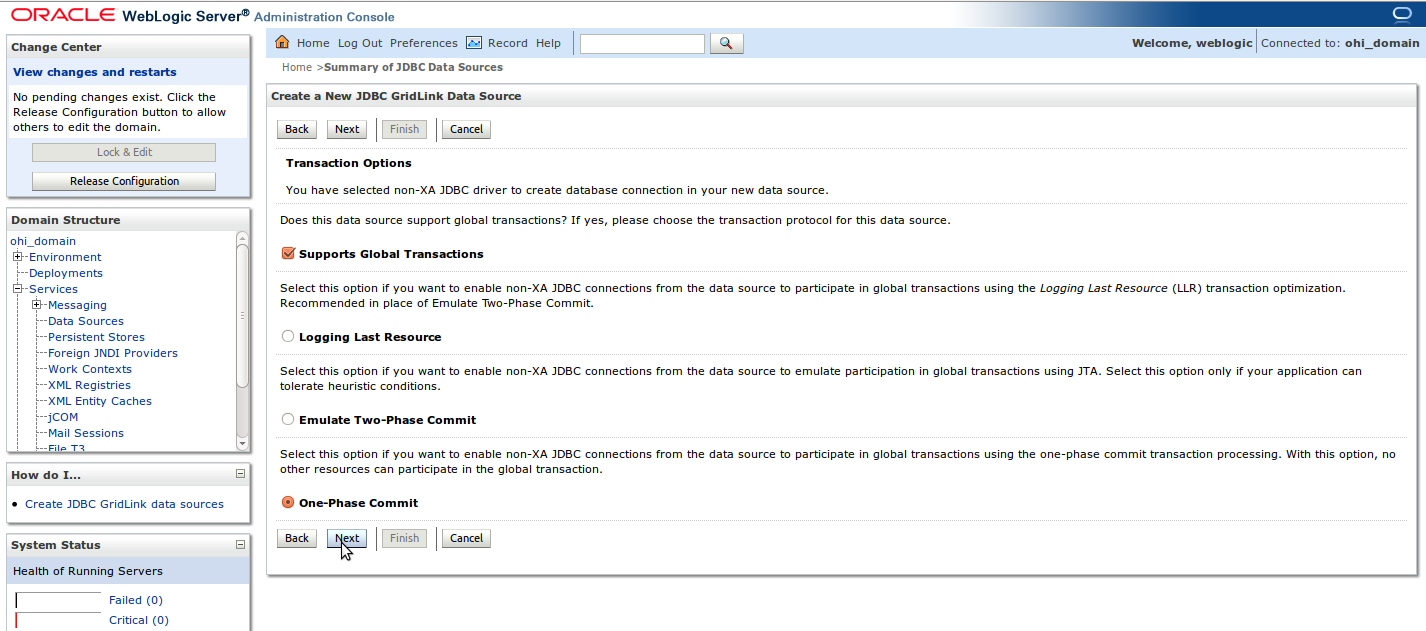
-
If SCAN (Single Client Access Name) is used for the Oracle RAC database, select the option Enter complete JDBC URL. Else, select the option Enter individual listener information.
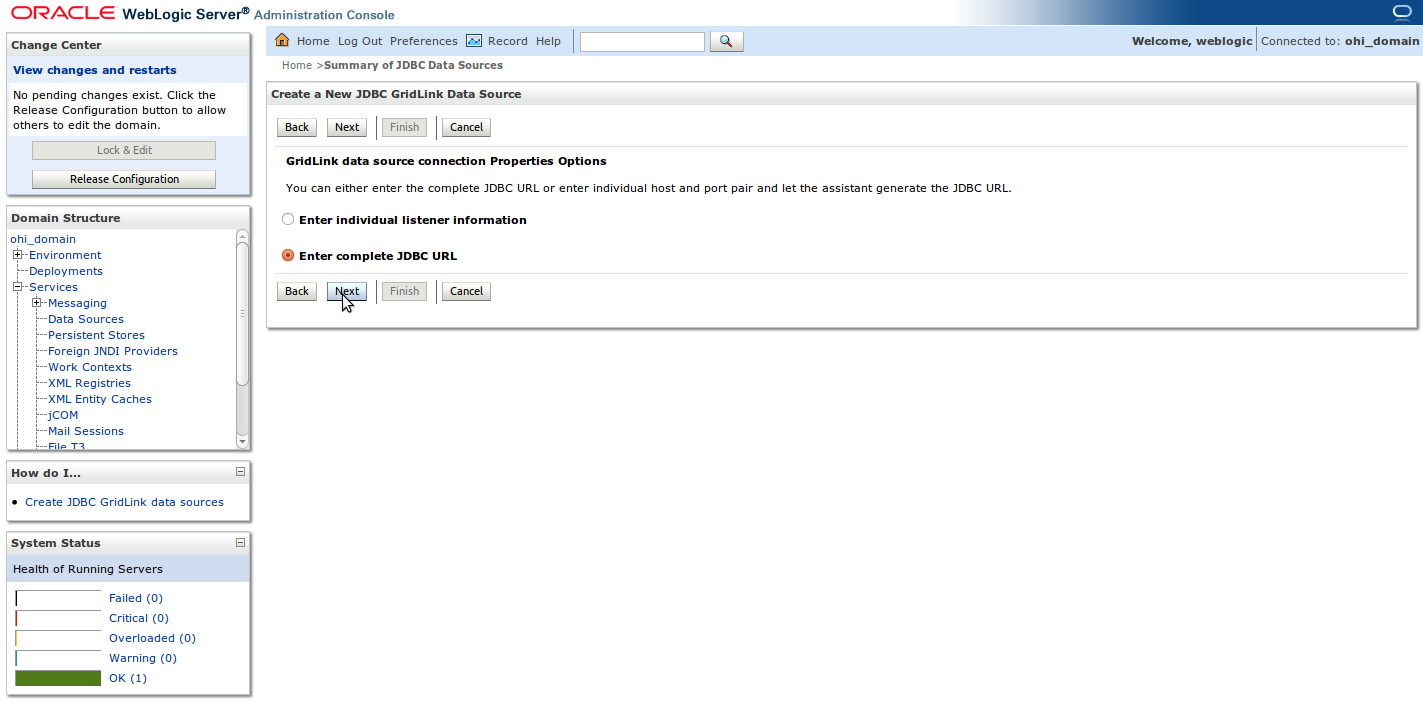
-
In the Connection Properties page either
-
enter the values of various fields as outlined in the table below if option Enter complete JDBC URL is selected:
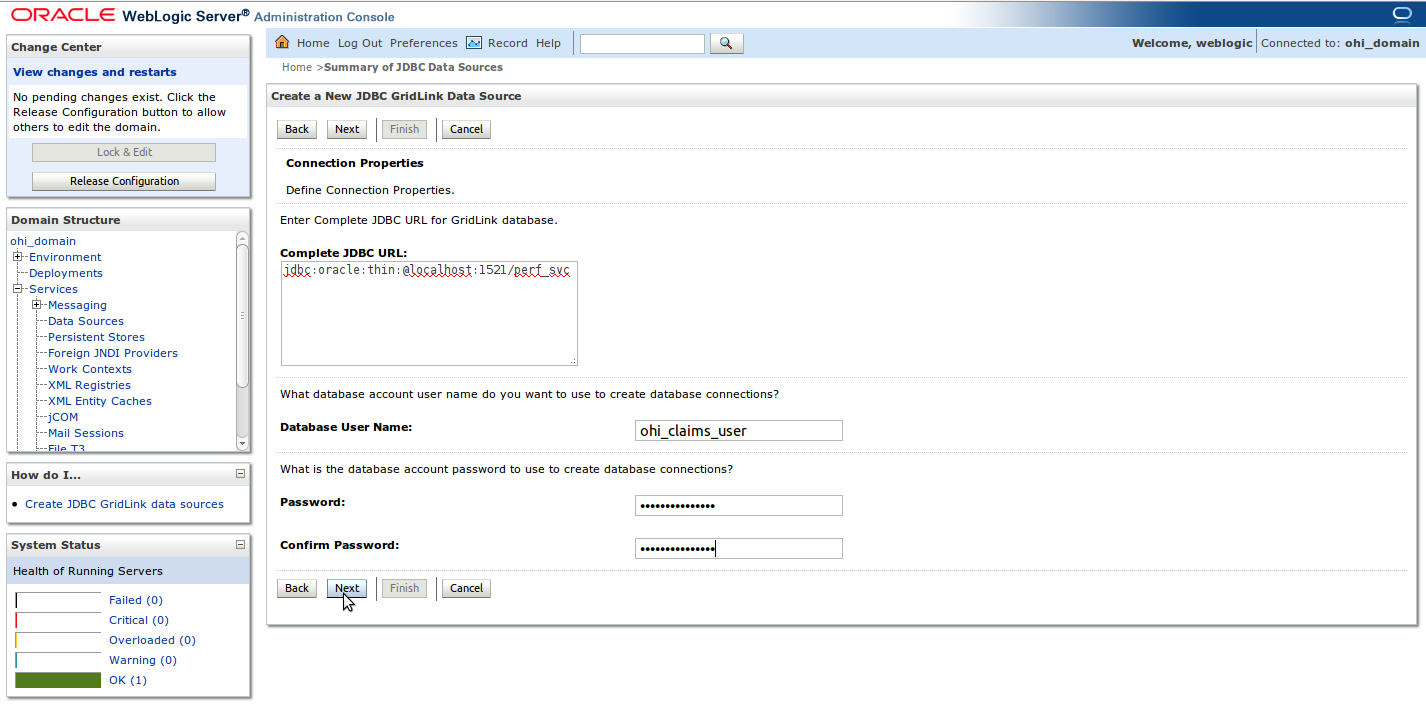
Table 4. Values to Enter Parameters Value Explanation Complete JDBC URL
jdbc:oracle:thin:@\{scan-listener-host}:\{scan-listener-port}/\{service-name}
JDBC URL using SCAN
Database User Name
ohi_claims_user
Fixed value, do not change
Password & Confirm Password
Password of "ohi_claims_user"
The schema password as selected during the installation
-
or enter the values of various fields as outlined in the table below if option Enter individual listener information is selected:

Table 5. Enter Individual Listener Information Parameters Value Explanation Service Name
Oracle RAC service name
Host and Port
hostname1:port
hostname2:port
Individual RAC node details. The format is <HOSTNAME>:<PORT>
Database User Name
ohi_claims_user
Fixed value, do not change
Password & Confirm Password
Password of "ohi_claims_user"
The schema password as selected during the installation
-
-
In the Test GridLink Database Connection page, click the Test All Listeners to see if the connection is successful. Once the test connection succeeds, click Next.
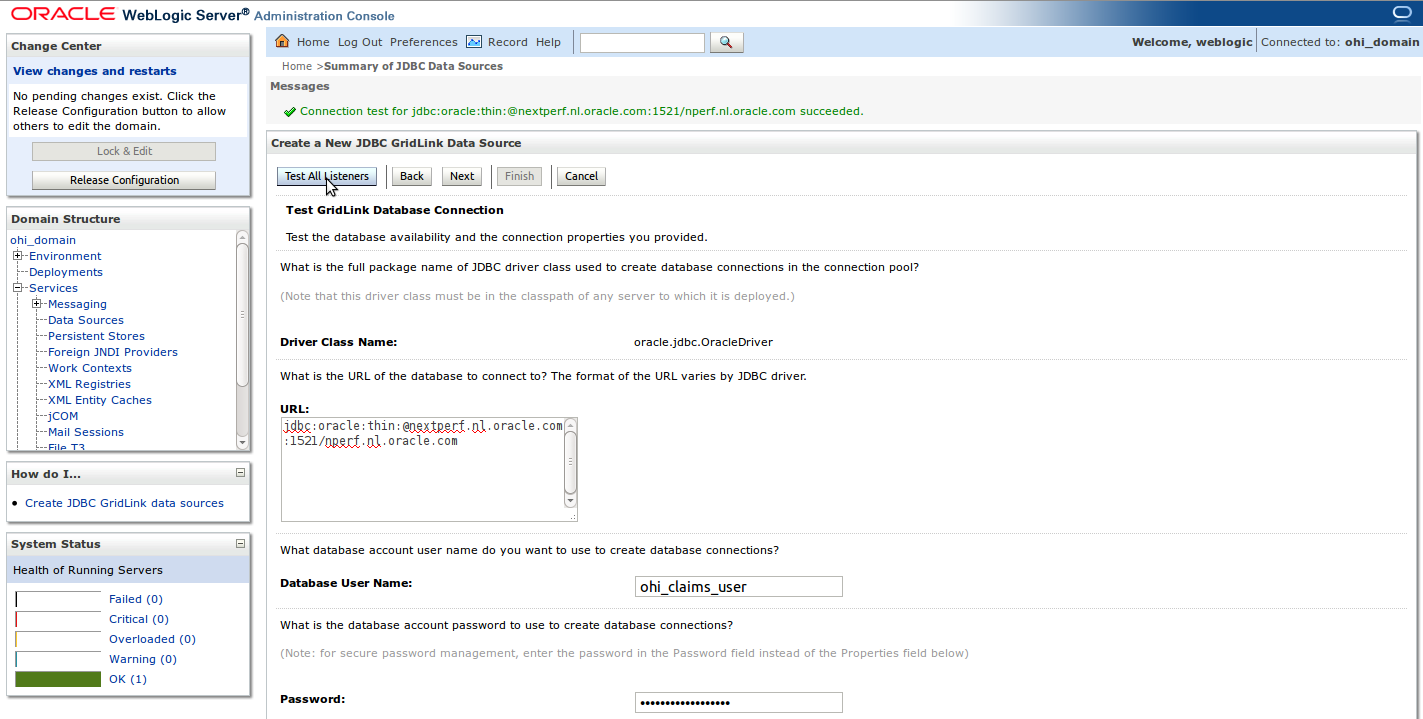
-
Enter the details of the ONS client configuration as outlined in the table below and click Next.

Table 6. ONS Client Configuration Parameters Value Explanation Fan Enabled
Check-box selected
Enables the data source to subscribe to and process the Oracle FAN events. This attribute is only applicable for the RAC configurations that publish the FAN notification events using the ONS protocol.
ONS Nodes
For example: hostname1:6200,hostname2:6200
A comma-separated list of ONS daemon listen addresses and ports to connect to for receiving the ONS-based FAN events.
ONS Wallet File
Location of ONS Wallet File (including the file name)
The location of the Oracle wallet file in which the SSL certificates are stored. Only required when the ONS client is configured to communicate with the ONS daemons using SSL.
ONS Wallet Password & Confirm ONS Wallet Password
The wallet password
The wallet password attribute that is included as part of the ONS client configuration string. This attribute is only required when the ONS is configured to use the SSL protocol.
-
Click Test All ONS Nodes to see if the connection is successful. Once the connection test succeeds, click Next.
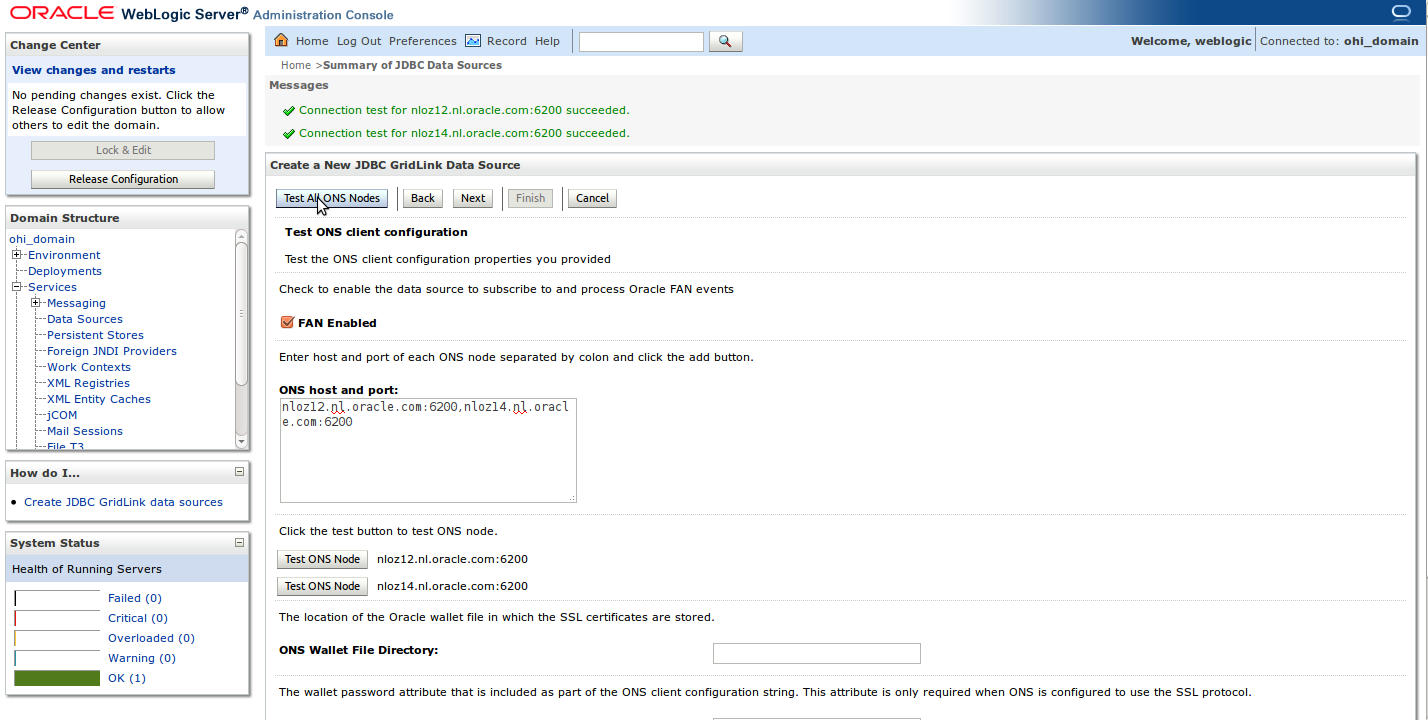
-
Select the Targets in the next page and click Finish.
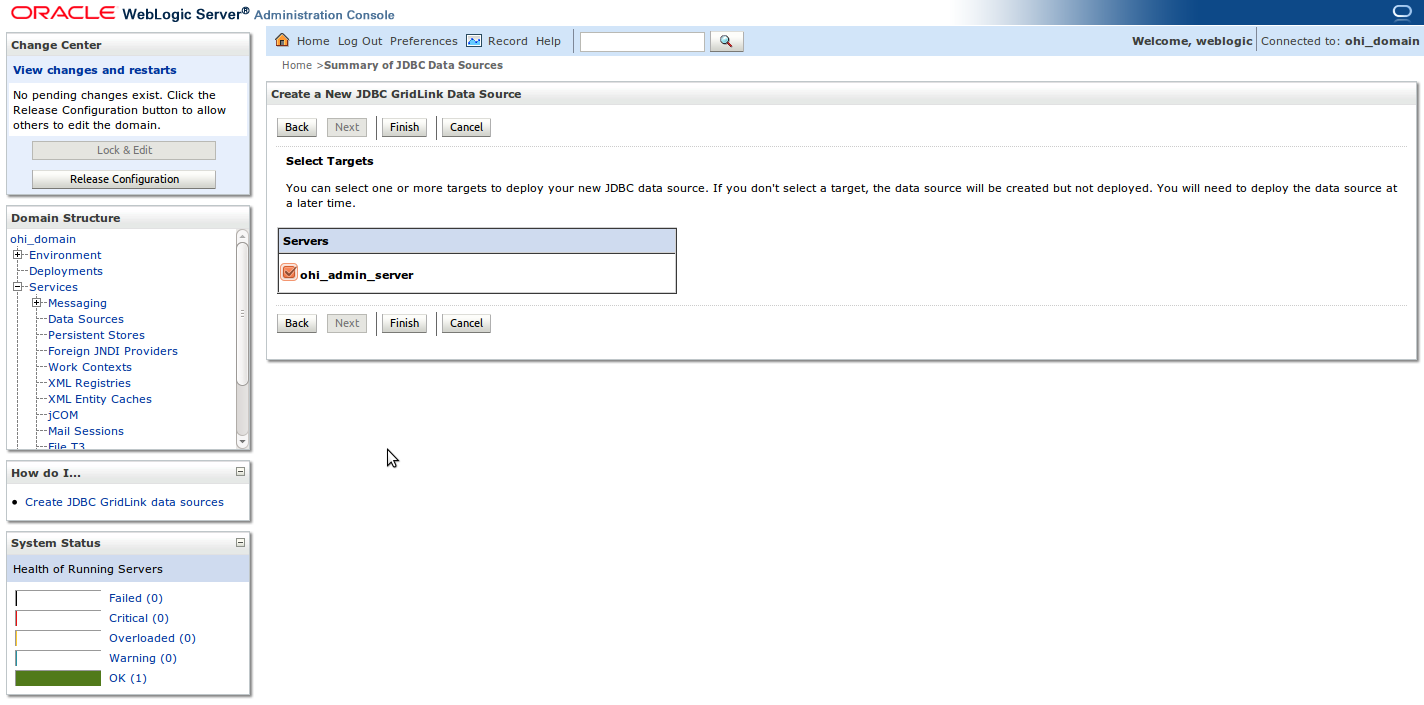
Make sure to specify the managed server as target for the GridLink Data.
Setting Advanced Properties for the Data Source
Whether for a single machine or RAC - the Data Source that has been created needs some additional advanced settings.
-
Select the newly created Data Source
-
Click the table Connection Pool
-
Expand the Advanced node at the bottom of the page to display all properties and set the following:
Table 7. Setting Advanced Properties for the Data Source Property Value Initial Capacity
0
Test Connections On Reserve
Checked
Test Frequency
300
Connection Creation Retry Frequency
30
Seconds to Trust an Idle Pool Connection
10
Statement Cache Size
The default value is 10. Increasing this to a higher value results in a better performance. Refer the WebLogic documentation for more details on this.
Wrap Data Types
Unchecked
Init SQL
When the users are in a different time zone then the database, the session time zone must be set with this statement:
SQL ALTER SESSION SET TIME_ZONE = '<time zone>', where <time zone> is the name of an Oracle RDBMS supported time zone.
The time zone names can be found in V$TIMEZONE_NAMES. -
Set the following driver property:
Table 8. Driver Property Property Value oracle.net.CONNECT_TIMEOUT
10000
Installing The Oracle Health Insurance Application through the Admin Server Console
Oracle Health Insurance applications are delivered in a so called Java Enterprise Archive (EAR) which is installed through the WebLogic Admin Server Console. In order to do that, perform the following steps.
-
Login to the Admin Server console (for example:).
-
Click the Deployment link and then click the Install button as shown in the following screenshot:
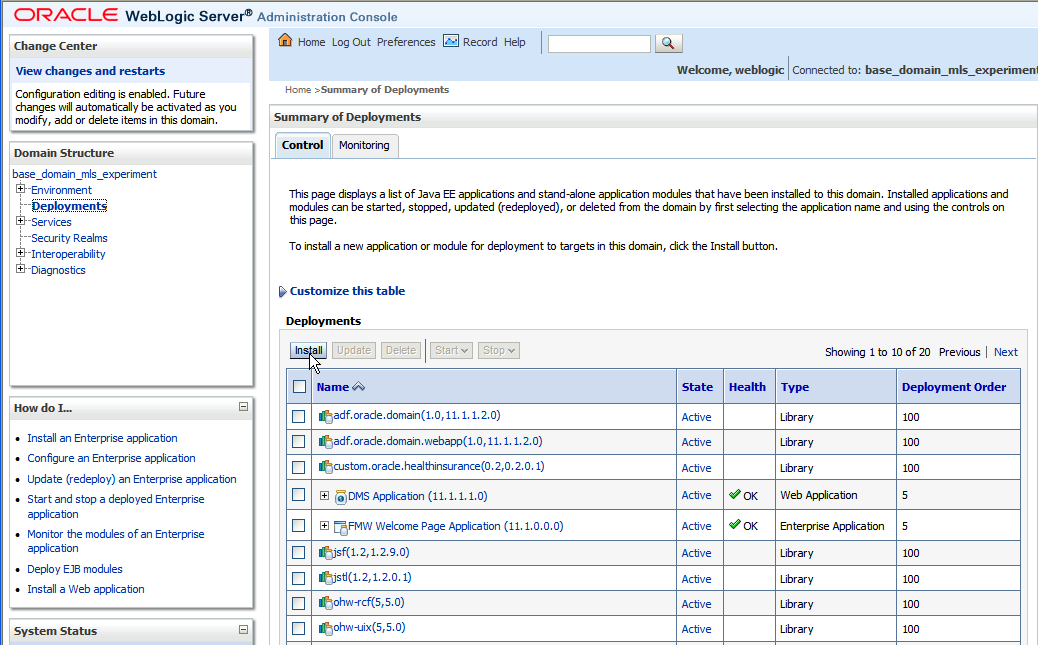
-
Select the path where the EAR file is located and click Next as shown in the following screenshot:

-
Select the option Install this deployment as an application and click Next as shown below:
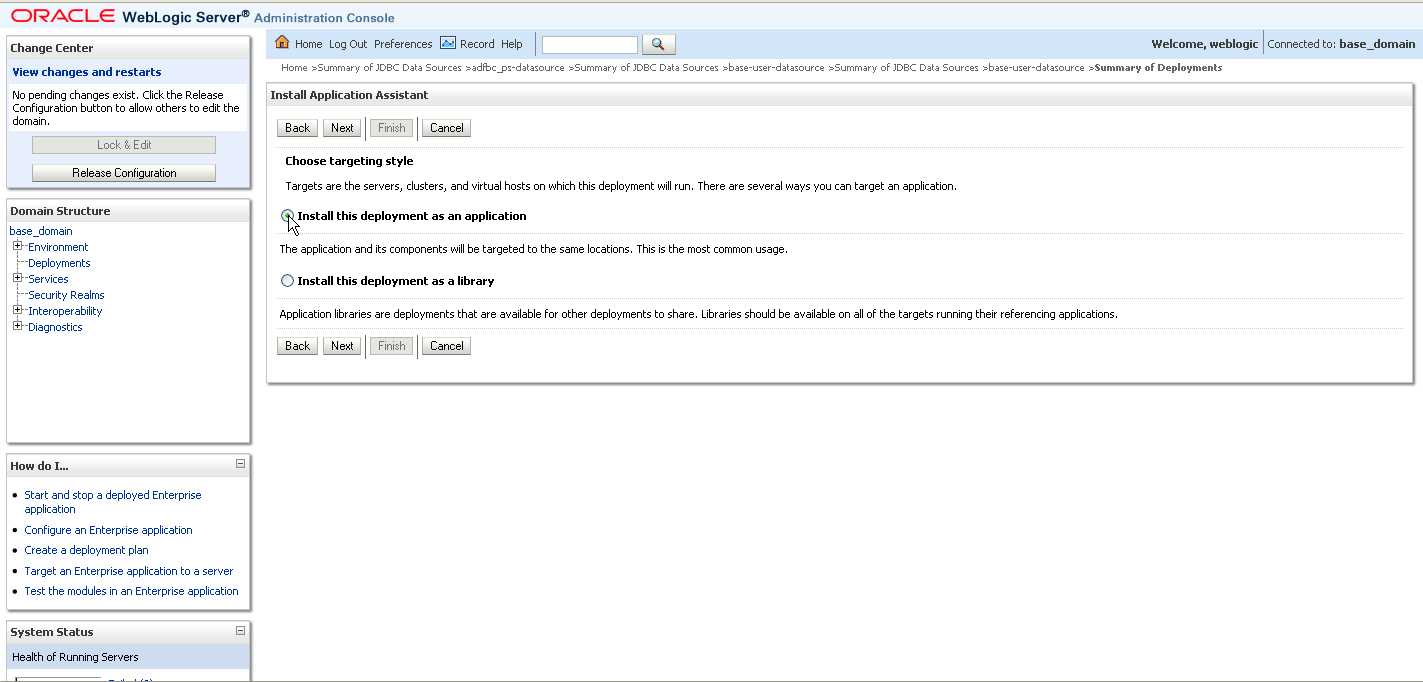
-
Click Finish. The Oracle Health Insurance application is now installed.
-
When deploying the application to cluster, in Select deployment targets page, select the Clusters target as shown below:
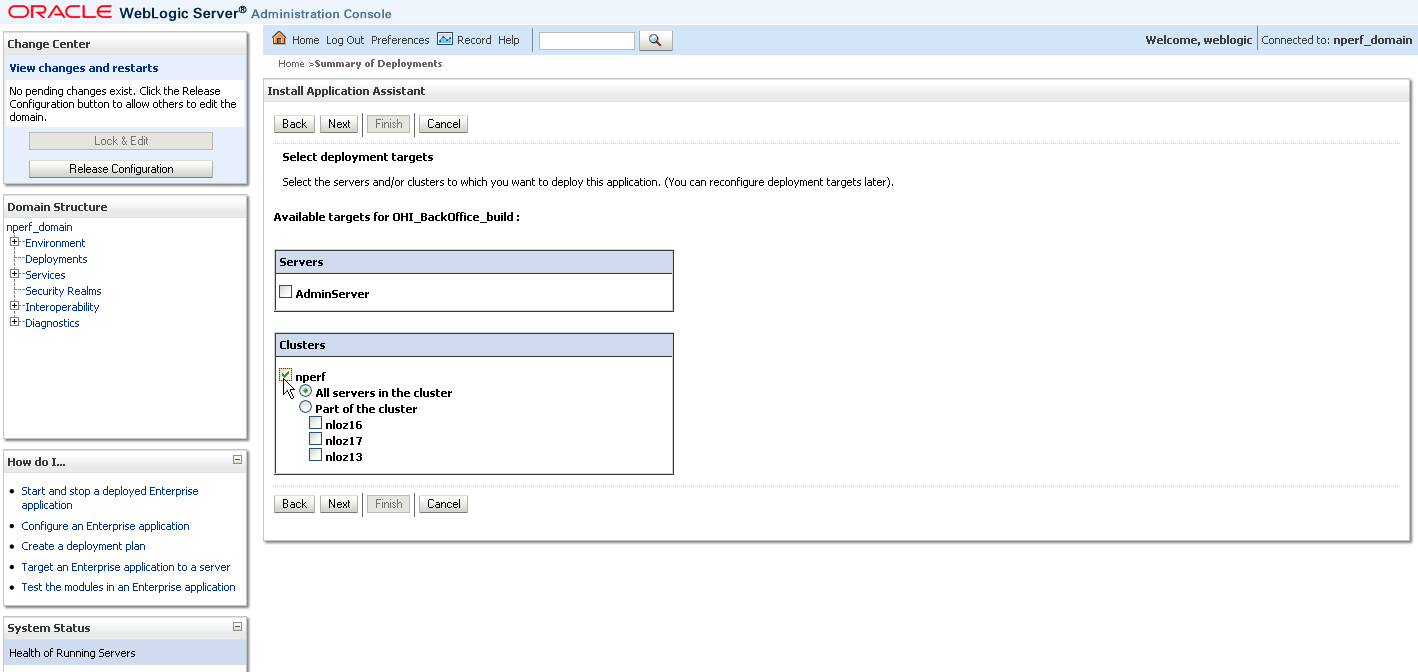
Installing The Oracle Health Insurance Application Through REST API
Post :http://<HOST-NAME>:<PORT-NUMBER>/management/weblogic/latest/domainRuntime/deploymentManager/deploy
{
"name": "<OHI-APPLICATION-NAME>.",
"applicationPath": "<PATH-OF-OHI-APPLICATION-EAR>",
"targets": ["<NAME-OF-CLUSTER>"],
"plan": "<PATH-OF-PLAN.xml>",
"deploymentOptions": {}
}
Changing the Context-Root for the UI or Web Services
Oracle Health Insurance applications consists of multiple modules. Each module is shipped with a default context-root. To change the default context-root of an Oracle Health Insurance application web application or an Oracle Health Insurance application web service, deploy the application with a customized deployment plan.
Refer to the section Configuring Applications for Production Deployment in the "Weblogic Fusion Middleware Deploying Applications to Oracle WebLogic Server" guide for details.
JET UI Installation
JET UI and the Web Services must be in the same origin. An origin is defined as a combination of the URI scheme, hostname, and port number. If the JET UI is on a different origin than the Web Services, the browser sends a preflight OPTIONS request for each actual GET request. Those OPTIONS requests are un-cacheable, effectively doubling the time needed to get to the data.
Changes That Require a Restart
There are some changes to the system that require a restart for the changes to take effect. Following is the list of such changes:
| Change | Description |
|---|---|
Add/Remove Insurable Entity Types |
If new insurable entity types are added then the system needs to create and assign dynamic tables for the type which requires a restart. If insurable entity types are removed then these tables need to be removed which also requires a restart. |
Changing default currencies |
If the default currency is changed then a restart is required for the application adapt to these changes. |